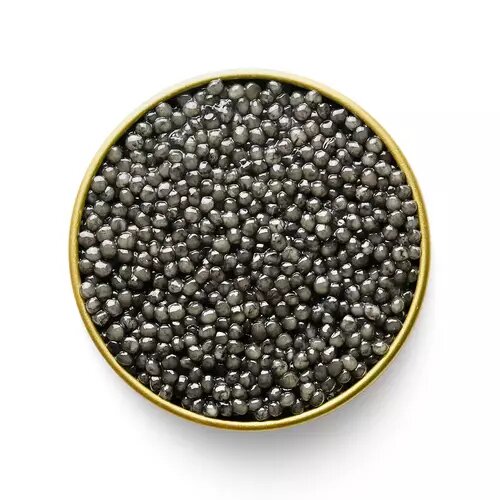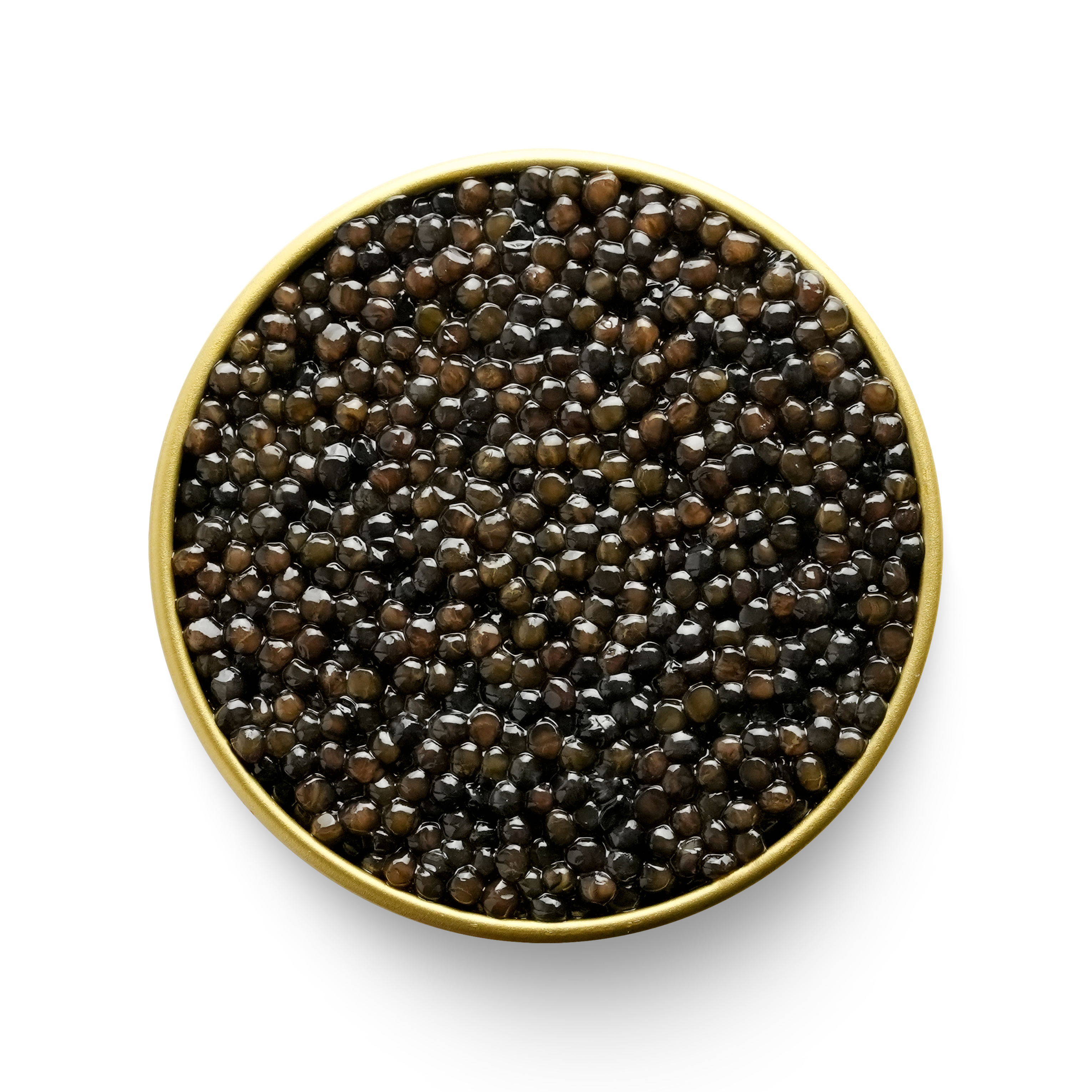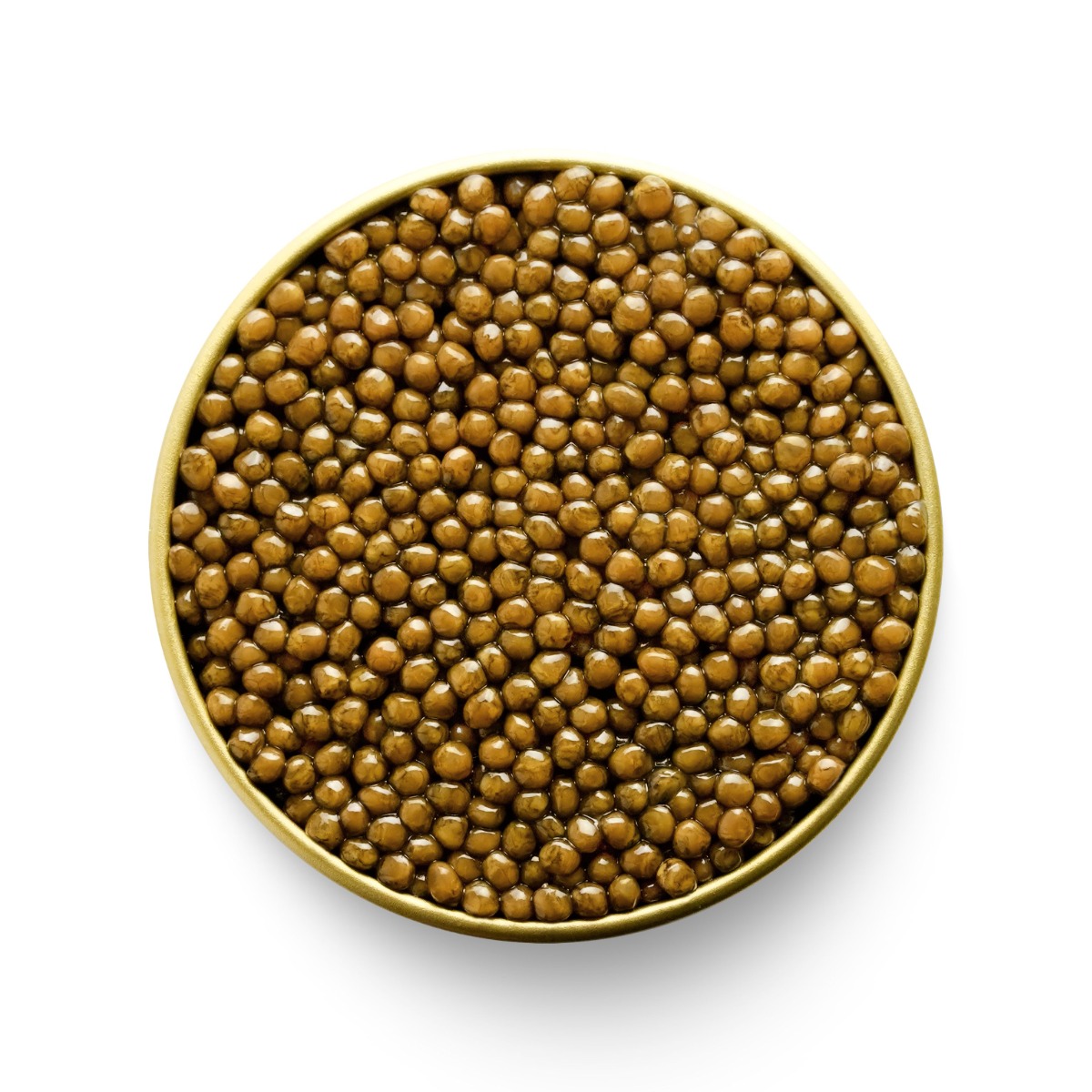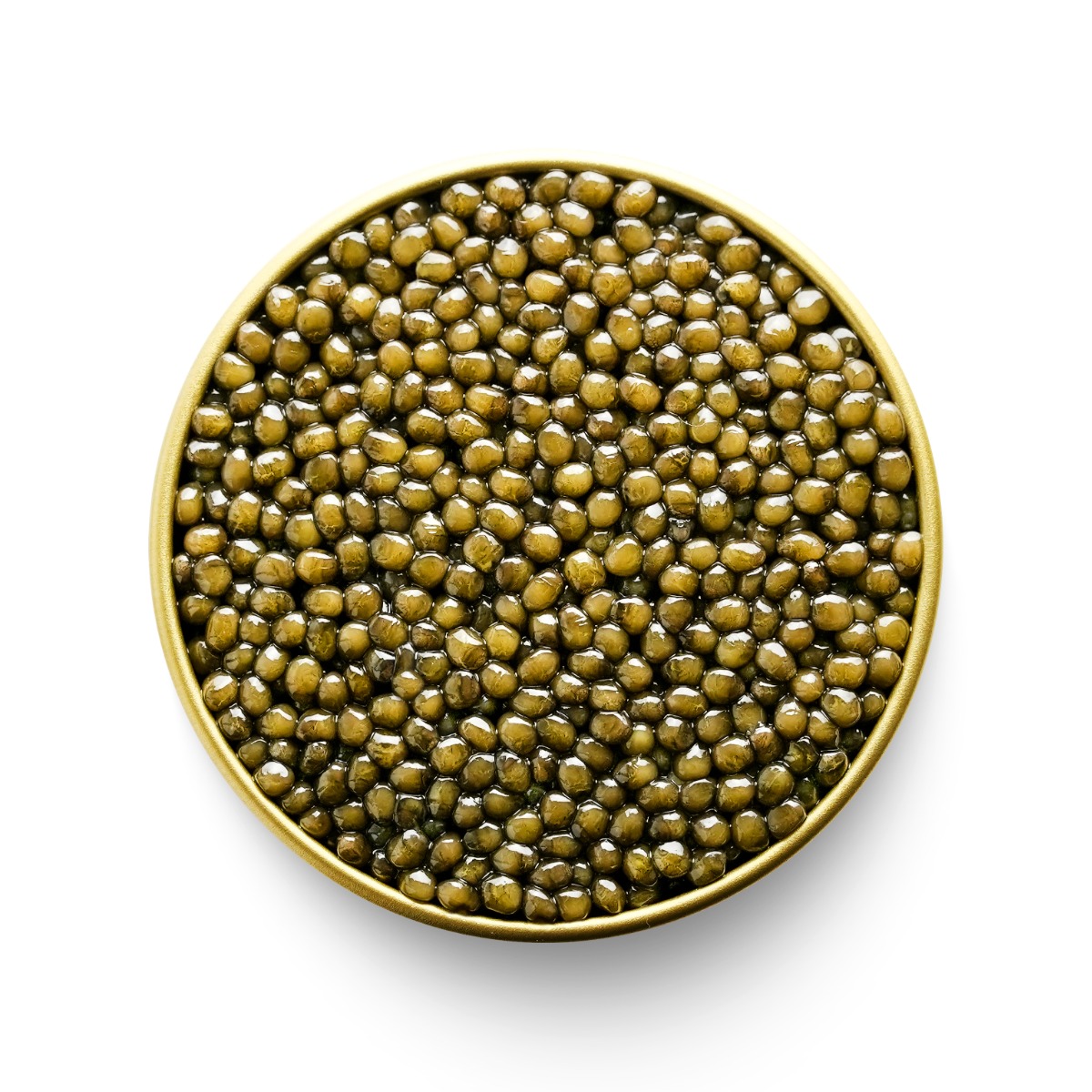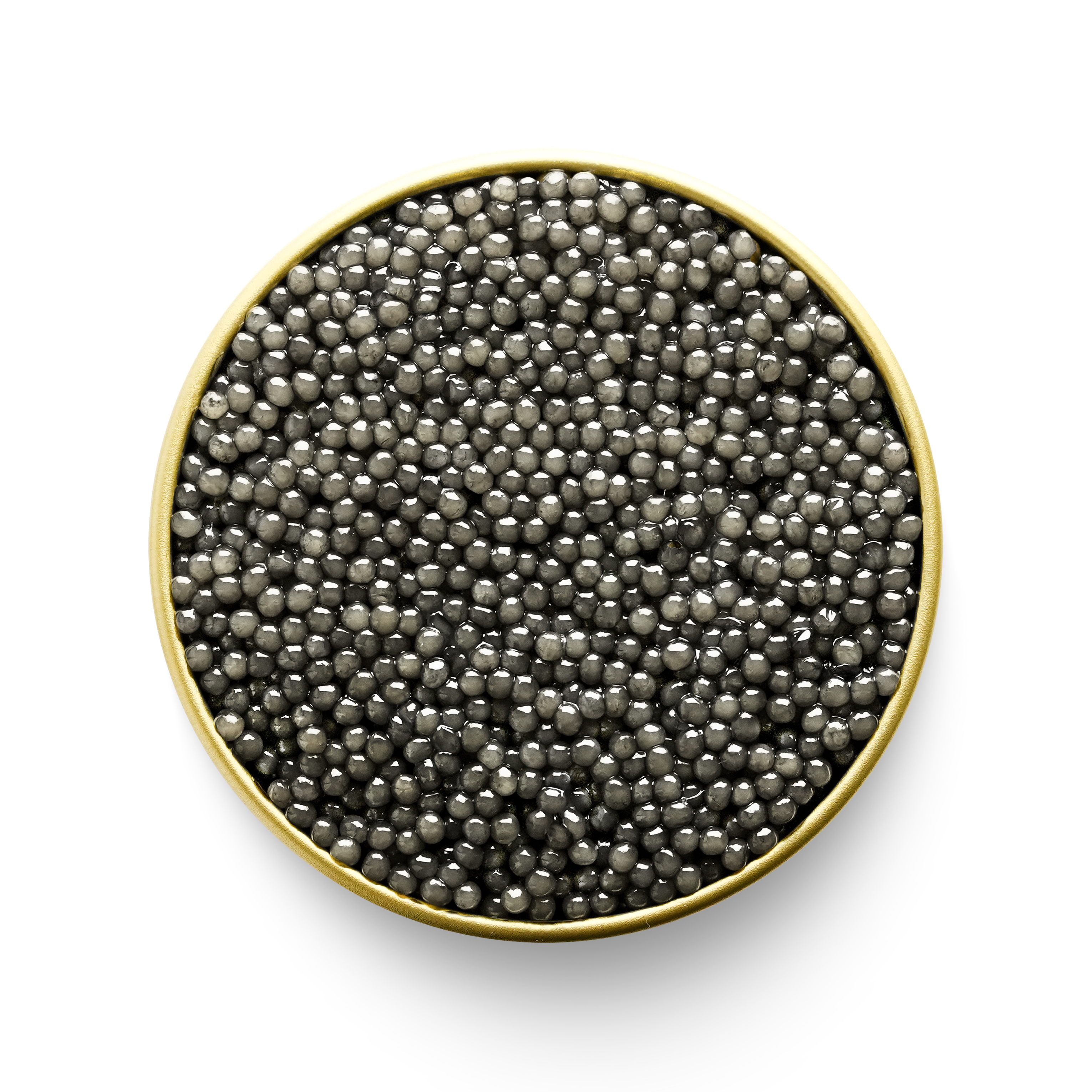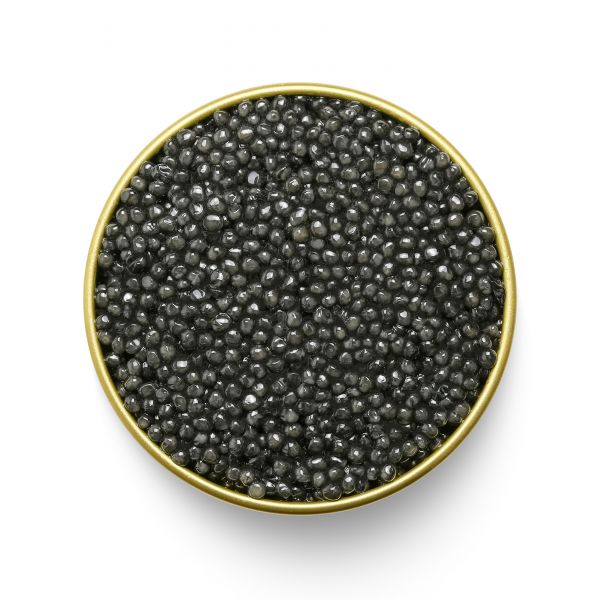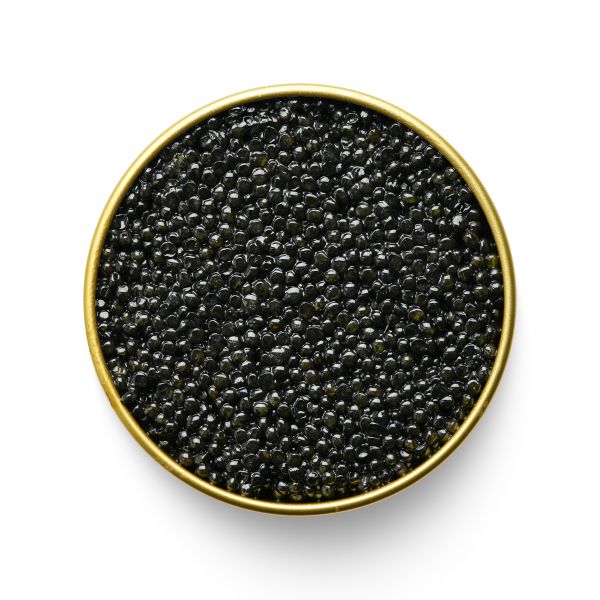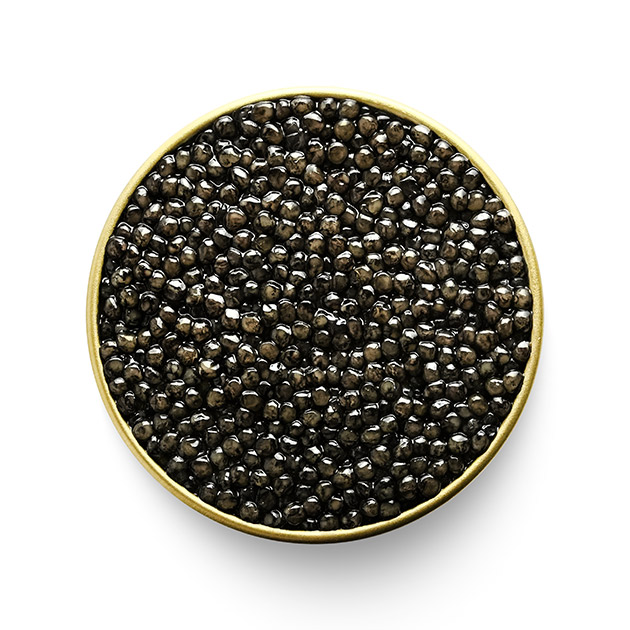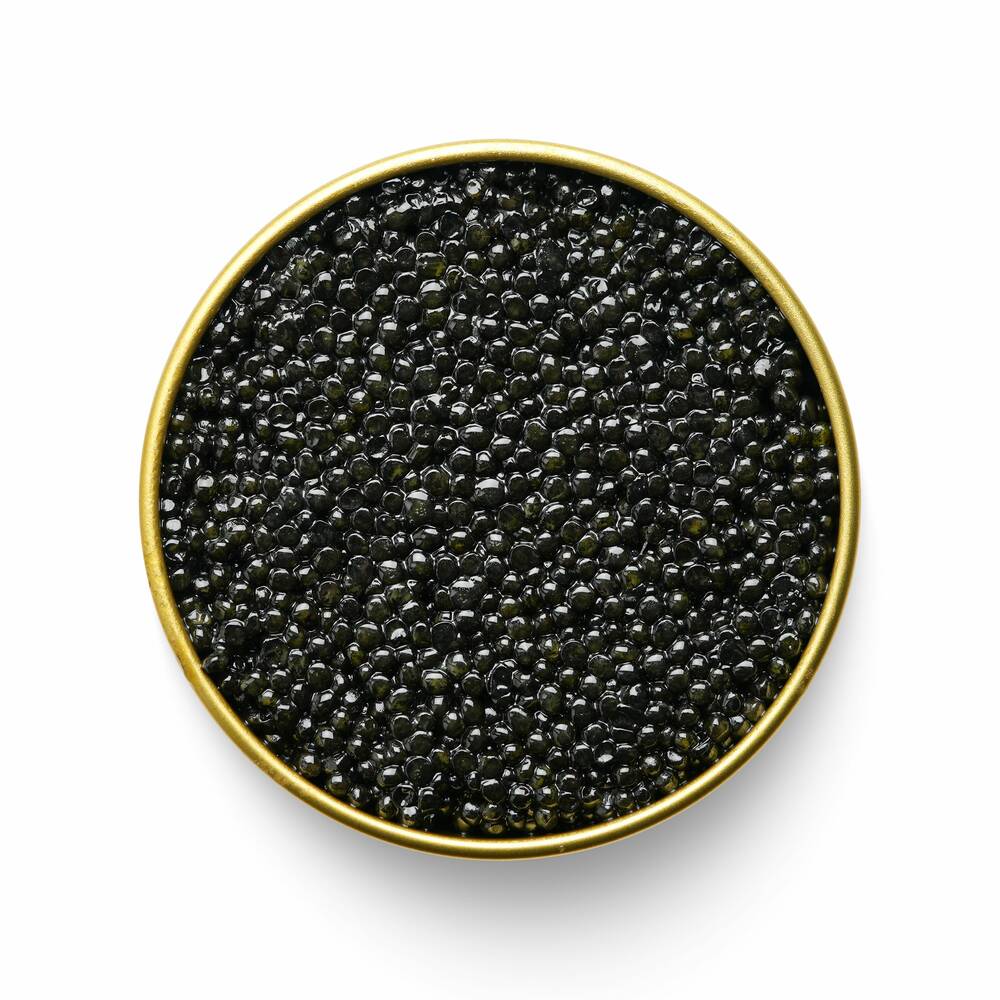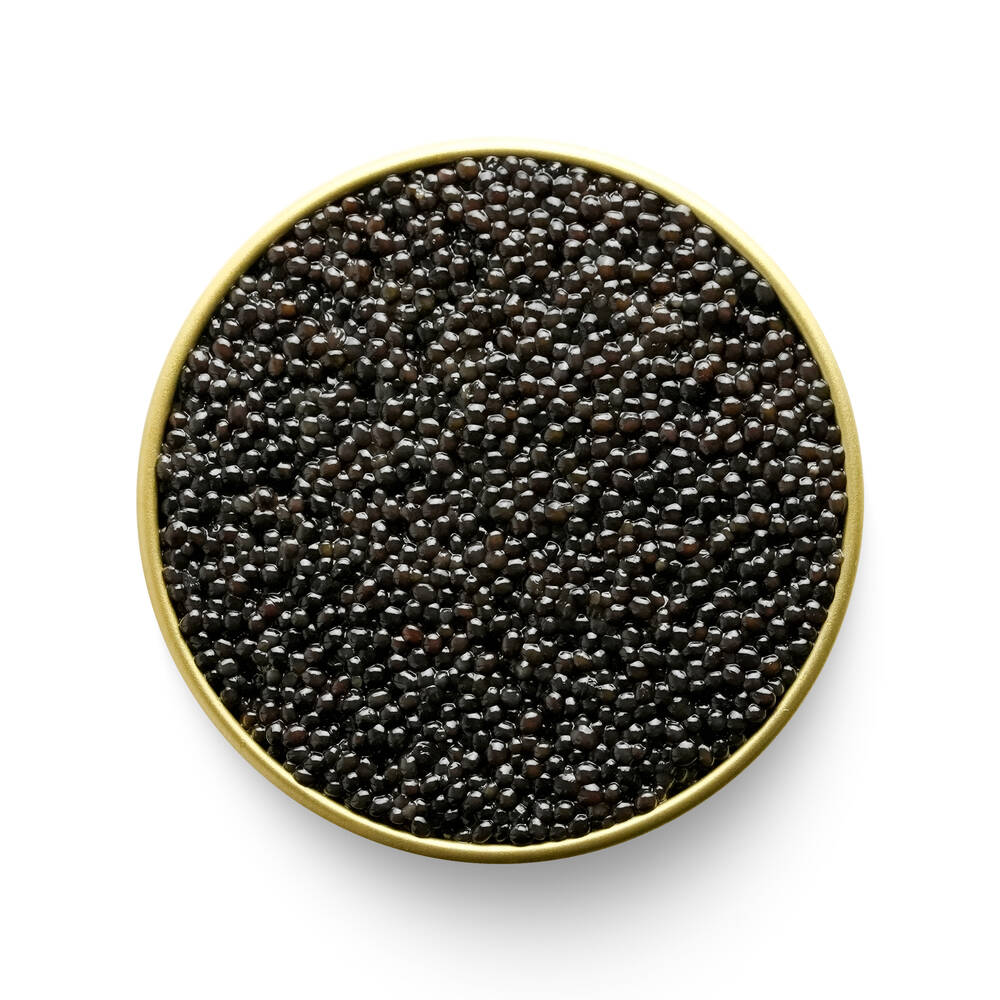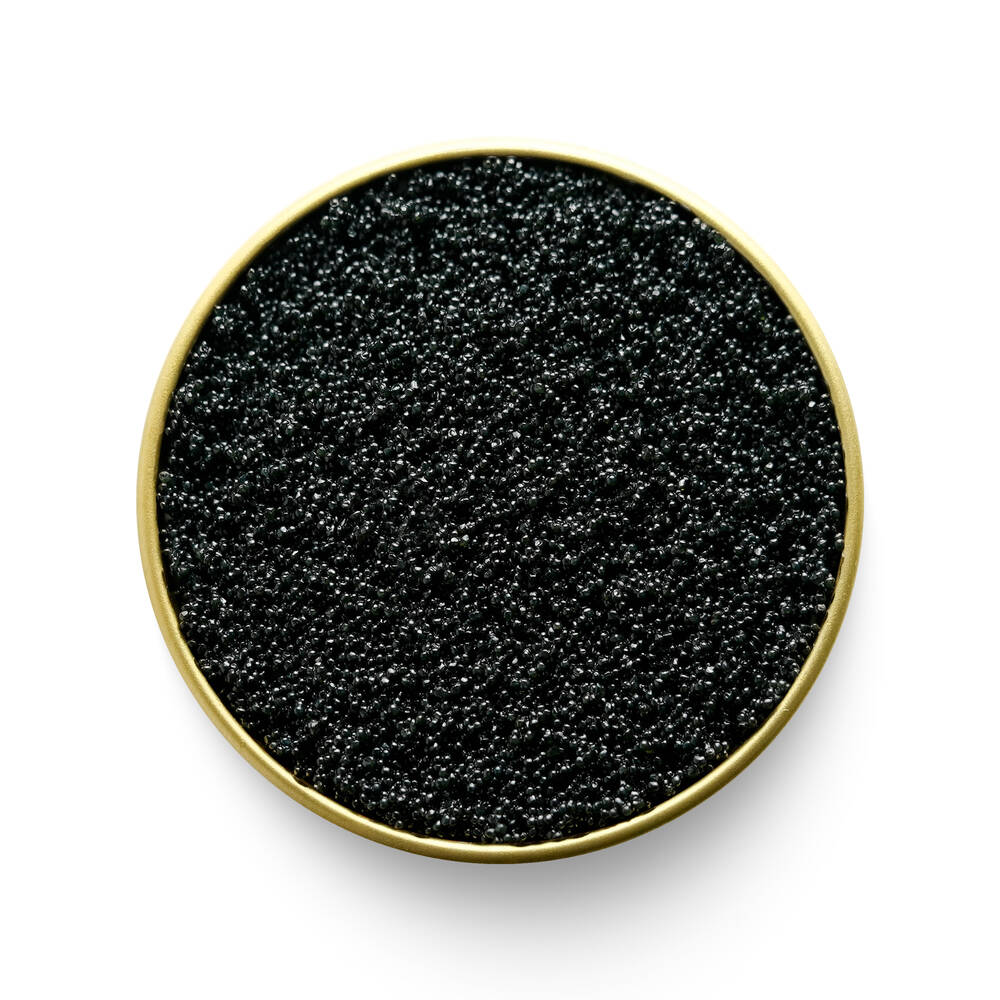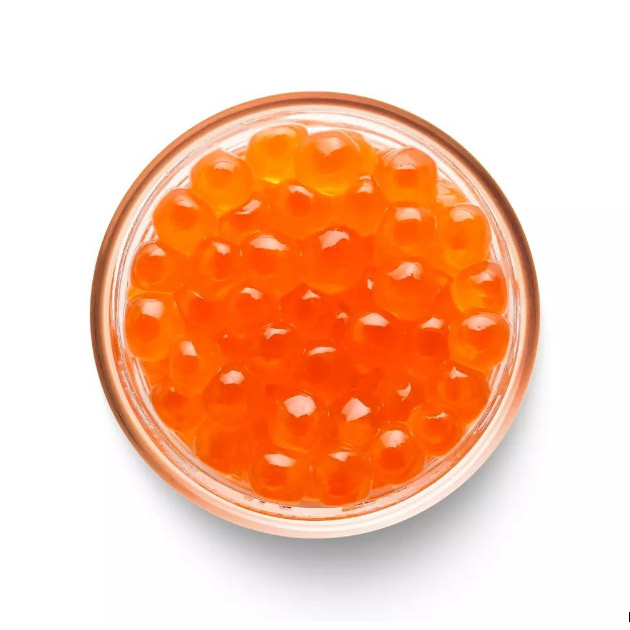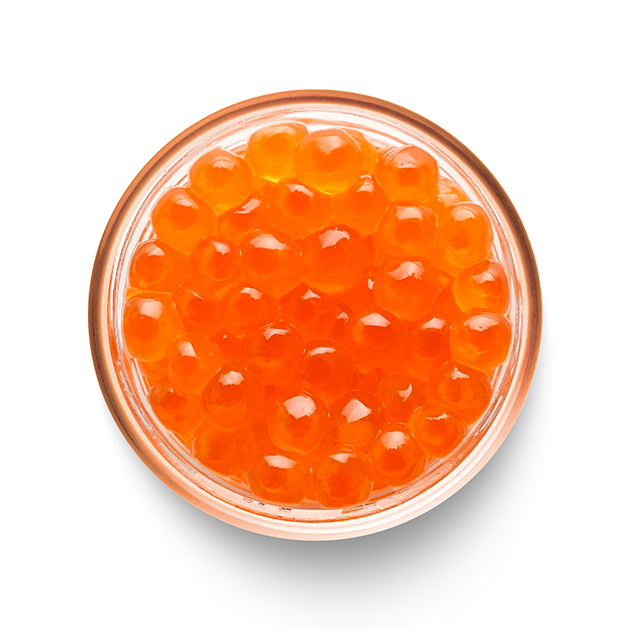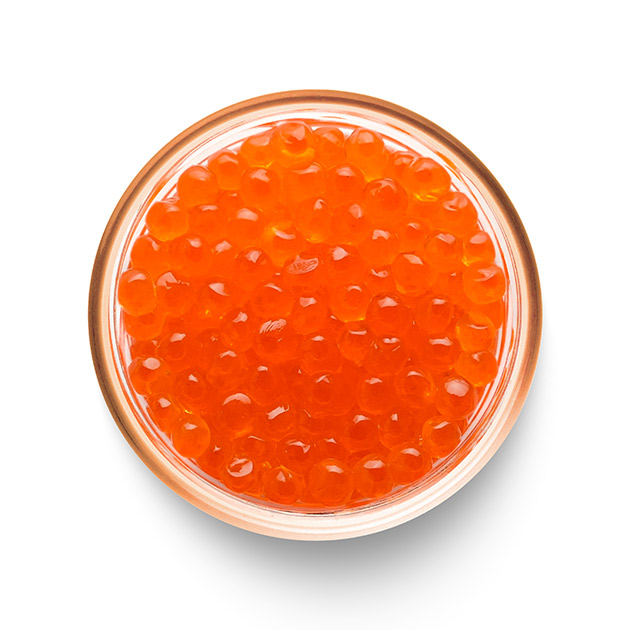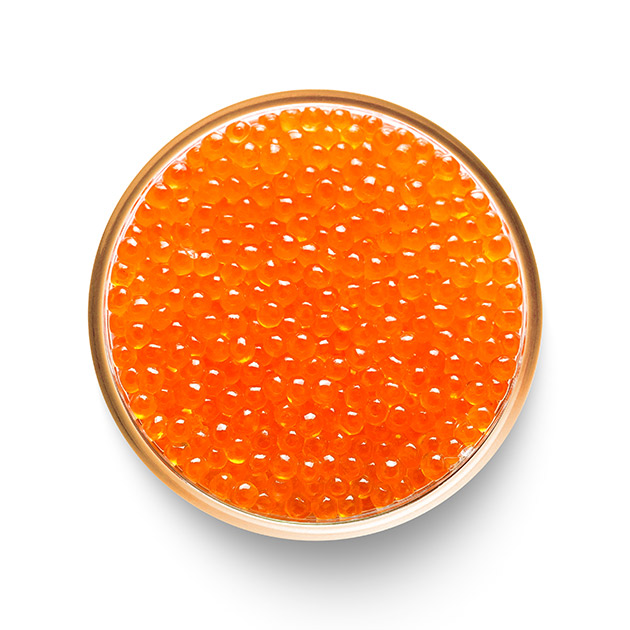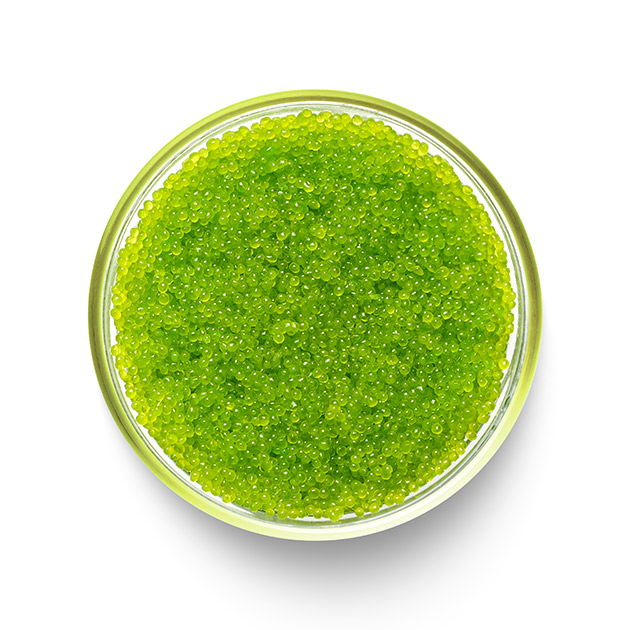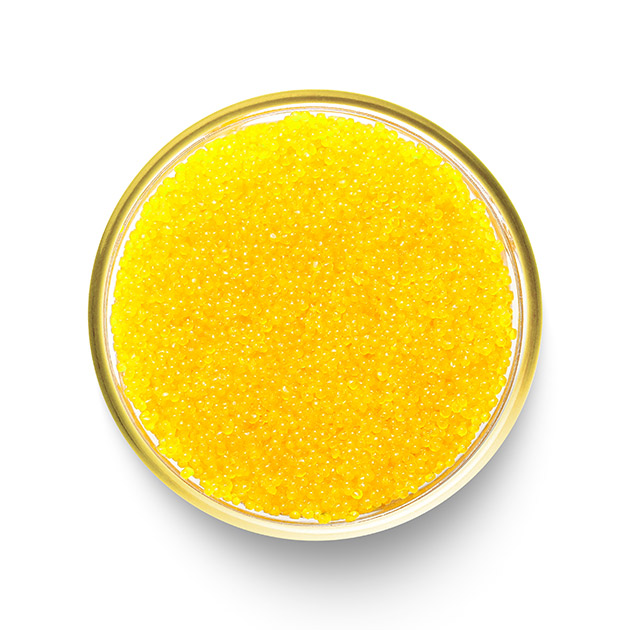Simply put, caviar is a delicacy consisting of processed, salted, non-fertilized sturgeon roe.
Traditionally, the designation “caviar” was only used for sturgeon roe obtained from wild sturgeon species living in the Caspian and Black Seas, including Beluga, Osetra (Russian Sturgeon and Persian Sturgeon) and Sevruga, so called the “True Sturgeons”. Today, this definition extends to include the roe of other sturgeon species, including Kaluga, Sterlet, Hackleback, Siberian Sturgeon, White Sturgeon, among others.
Depending on a country’s national laws, the word “caviar” can also be used to describe the roe of both sturgeon species and non-sturgeon fish, such as Paddlefish, Bowfin, Salmon, Steelhead, Trout, Capelin, Flying fish, Stromluga, Lumpfish and Whitefish.
According to the United Nations’s Food and Agriculture Organization, roe from any fish not belonging to the order of Acipenseriformes are not considered caviar, but caviar substitutes. This position was also adopted by the Convention on International Trade in Endangered Species of Wild Fauna and Flora (CITES), the World Wide Fund for Nature, the United States Customs Service, and the Republic of France. However, if the name of the fish is identified, the word “caviar” can be used. For example: “Salmon Caviar”, “Bowfin Caviar”, “Lumpfish Caviar”, “Trout Caviar”, etc.
Note: Because this position was adopted by the United States Customs Service, all products of non-sturgeon origin that are exported from the U.S. must indicate “ROE” on customs declarations.
For a long time, caviar was considered an inaccessible delicacy reserved for the wealthy. Nowadays, the different varieties of caviar and caviar substitutes have allowed caviar to become more available and affordable for the general public. You сan always find a caviar or caviar substitute for a reasonable price. However, some caviar types (like gold caviar, derived from older sturgeon fish, or Private Stock caviar, derived from the best batches of caviar) are still the most expensive and exclusive. Nevertheless, many have come to be able to afford this delicacy and have tried different kinds of caviar as an appetizer or hors d'oeuvres.
Today, caviar is marketed worldwide as a delicacy and is consumed with hors d’oeuvres, as a garnish, or an appetizer during special events, weddings, and cocktail receptions. Caviar is also a part of menus at many five-star restaurants, Michelin restaurants, exclusive lounges, and high-end hotels.
Did you know that caviar is the oldest kind of delicacy? It was first mentioned in Greek writings from the 3rd century BC. After Greece, it became popular in Ancient Rome. The word “khaviar” appeared in written records from the 13th century.
Caviar should only consist of fish roe mixed with salt. If you find any other ingredients in caviar, beware that this is either not real caviar or highly preserved and processed caviar that uses chemicals.
You can hardly understand or value the taste of caviar during your first bite of it because it has an unusual flavor which can be sensed throughout an extended length of time. Furthermore, it is better to try different kinds of caviar to explore the many varieties of caviar and discover your own preferences. To truly understand the taste of caviar, you need to try it at least two or three times.
How to Know Caviar is Good
In order to assess whether the quality of the caviar you’ve purchased or are being served is good or not, you must look at the caviar and smell it. High quality caviar must have a bright color and a natural ocean-like aroma. In contrast to popular belief, high quality caviar shouldn’t smell or taste fishy. When observing caviar, make sure that the individual fish eggs (beads) are consistent in size and appearance throughout. Likewise, make sure the texture is not mushy. Each individual fish egg must be hard enough to come through the preparation process fully intact and still be delicate enough to melt in your mouth while you are eating it. A shiny, pearl-like exterior to the eggs also demonstrates the freshness of caviar.
However, please note that all caviars will vary in color, appearance, size, texture, and other qualities due to it being derived from different species of sturgeon raised under different conditions in different areas across the world. For example, Beluga caviar is currently the most expensive and rarest caviar in the U.S. This is because only our subsidiary farm, Sturgeon AquaFarms, is legally allowed to commercially sell Beluga caviar due to an exemption from the FWS ban on it. To demonstrate some major differences across caviars derived from various sturgeon species, consider that Beluga caviar has the largest eggs of all sturgeon caviars due to the large size of Beluga sturgeon. In contrast to Beluga, Osetra caviar has a more nutty flavor and creamy texture. Whereas, Sevruga caviar has smaller beads and a stronger taste and is ideal for a caviar aficionado that wants to explore something less traditional.
Caviar Health Benefits
Some really important facts about caviar include its really helpful qualities that contribute to good health. Caviar contains protein, Vitamin B12, Iron, Calcium, Omega-3 Fatty Acids, Vitamin A, Selenium, and Magnesium.
CAVIAR CAN HELP:
- Improve heart health
- Lower blood pressure
- Boost immune function
- Strengthen bones
- Nurse a hangover
- Improve memory problems
- Prevent cancer,
- Improve your eyesight
All things considered, caviar is a top-tier delicacy and gourmet food product. Among species, it varies in its taste, tint, texture, and size of the eggs. There are various kinds of caviars across the spectrums of taste, color, texture, size, and price. Marky’s is ready to provide you with a great selection of high quality caviar to buy from some of the best and most sustainable caviar farms around the world.
Types of Caviar
Marky’s Beluga Caviar (Huso Huso)
In June 2003, together with our subsidiary Sturgeon AquaFarms (SAF), located in Bascom, FL, we brought live Caspian Sea sturgeon into the United States, including Beluga and Sevruga. On October 6, 2005, the U.S. Fish and Wildlife Service banned all Beluga products from being imported into the United States. Today, we have been successfully breeding and raising Beluga sturgeon at SAF in North Florida. In July of 2016, Sturgeon Aquafarms (SAF) in Bascom, FL became the first and only facility in the world to obtain a permit exemption for the trade in Beluga sturgeon and its caviar in the USA. Since 2017, SAF has assisted in Beluga sturgeon repopulation efforts across the world by providing over ~160,000 fertilized beluga eggs to the Caspian Sea region.
Product characteristics:
- Farm-raised
- Sturgeon AquaFarms, Florida USA
- Light to dark grey colored pearls with hints of gold
- Firm, very large sized beads
- Smooth, silky texture
- Sweet, nutty flavor, hints of fruit and flowers
- Lingering buttery finish
- Excellent served alone, just on a mother of pearl spoon
Suggested Use: Sturgeon Aquafarms is the only aquafarm in the United States that is legally allowed to raise Caspian Beluga sturgeon. Marky’s Caviar is an exclusive distributor of SAF products and is currently the only company in the U.S. to sell domestic Beluga Caviar from SAF. Our customers have exclusive access to this delicacy. This one-of-a-kind product is in great demand among high-end restaurants, bars and caviar connoisseurs. Beluga caviar adds exclusivity to any event, party or menu of an exquisite restaurant and enhances any fine dining experience.
Note: The most common substitute for Beluga caviar in Europe is a hybrid between Beluga sturgeon and Sterlet sturgeon—known as Bester it is often incorrectly sold as Beluga caviar.
Beluga (Huso Huso) is listed as a “critically endangered” species on the IUCN Red List and strictly protected by CITES. It is the largest fish of the sturgeon family. Beluga can grow up to 24 feet and weigh up to 3,460 lb. It can live up to 118 years. Regardless of all the
efforts made by the surrounding Caspian Sea countries, CITES and the IUCN to preserve the natural stock, the wild population of Beluga is still declining. Its natural habitats are the basins of the Black, Caspian and Azov Seas. Beluga is completely extinct from the Black Sea and its basin. Male beluga matures at the age of 10-15 years and females at the age of 15-18 years. They spawn every 3-4 years. The spawning period is April through June. In the wild, Beluga sturgeons feed on small fish - herring, gobies, roach, kilka, etc. What are you waiting for buy beluga caviar at markys now from online.
If you are looking to buy the best quality Beluga caviar in America then it's time to head over Marky’s Online Gourmet Store. You can purchase "Beluga caviar online now"(link) and enjoy great offers.
Attention: CITES certificate needed for export of this product.
Beluga Hybrid (Huso Huso x Acipenser Baerii)
Due to the lack of availability of Beluga (Huso huso) caviar and the complexity of farming the species, many producers began cross-breeding Beluga with other faster producing sturgeon species. This product exhibits the size and flavor profile of Beluga, coupled with the speed of production of the smaller Siberian Sturgeon (Acipenser baerii) to provide a more affordable and readily available alternative to the exclusive and scarcely available Beluga caviar.
Product characteristics:
- Farm-raised
- Italy
- Brownish grey colored pearls
- Very large firm beads
- Smooth, silky texture
- A milder buttery note than traditional Beluga with a hint of the earthy and nutty tones of premium Siberian sturgeon
- Lingering buttery finish
- Excellent served alone, just on a mother of pearl spoon
Suggested Use: This one of a kind product will be in great demand among high end restaurants, bars and individuals. Any relation, no matter how distant, to original Beluga caviar will definitely add exclusivity to any event, party or menu of an exquisite restaurant and will enhance any fine dining experience.
Head over to Marky's Online Gourmet Store and purchase the best quality hybrid beluga caviar in America. With great offers, there is no better place for this delicacy than right here!
Kaluga Fusion Caviar (Huso Dauricus x Acipenser Schrenkii)
Product characteristics:
- Farm-raised
- Qiandaohu Lake
- Black: Black, with hints of chestnut color pearls
- Amber: Amber brown to olive green color pearls with hints of gold and chestnut
- Gold: Bright light golden to golden olive color pearls, with hints of brown
- Note: Color ranges from black, to amber, to gold, the lighter the color, the more rare and nuttier tasting the caviar is.
- Very firm, large individual beads
- Mellow, rich, buttery taste
- Crisp finish
- Best served on a blini with crème fraiche or other accompaniments
- Drinks: Brut Champagne or a dry white wine (Sauvignon Blanc, Pinot Grigio)
Suggested Use: Kaluga Hybridized sturgeon, a cross between Kaluga and the Amur Sturgeon (Huso Dauricus x Acipenser Schrenkii) are farm raised in the Qiandaohu Lake, in a freshwater environment close to their natural habitat that is free of pollutants. Kaluga Fusion, our trade name for this unique caviar, makes a great substitute for the lack of Beluga due to its related genus. As such, it should be suggested to those who are interested in purchasing something similar. This caviar’s distinctive savory taste, with hints of fruit and nut, will add a note of exclusivity and sophistication to any table and make a wonderful addition to the menu of any high-end restaurant or cocktail lounge. Kaluga Fusion caviar is best served with a blini and a glass of dry white wine or Brut Champagne. Beware that Kaluga caviar is incorrectly marketed as River Beluga and a substitute for Caspian Beluga Caviar. Pure Kaluga caviar (Huso Dauricus) is, as of September 2014, illegal to import into the United States.
Note: Hybrids of Kaluga Sturgeon and Amur Sturgeon (Acipenser Shrenkii) are incorrectly sold as Osetra caviar or as Royal Caviar. Due to the specifics of this species, caviar obtained from the cross bred generation resembles Russian Osetra in color and appearance of the pearls, but the taste is quite different. Cross breed products are very abundant in Europe and China, so beware of the source of your caviar and ensure the species is indicated on the CITES label.
Kaluga Sturgeon (Huso Dauricus) experienced an 80% population decline in the last 90 years and it continues to decline. Kaluga Sturgeon is listed as a “critically endangered” species on the IUCN Red List and strictly protected by CITES. Kaluga Sturgeon can reach up to 18.6 feet and weigh up to 2,205 lb. This is the largest freshwater fish in the world. Kaluga can live up to 80 years. Females reach sexual maturity at the age of 14-23 and spawn every 4-5 years. They carry about 41,000 eggs per kg of body weight. Males reach sexual maturity at the age of 14-21 and spawn every 3-4 years. They spawn from May through July. Kaluga sturgeons are native to the Amur River basin (Russian Federation & China). It is a semi-anadromous fish. Kaluga never goes to the salt waters of the sea, but lives in the semi-salted waters in the mouths of large rivers and spawns upstream in freshwater. Kaluga lives in all types of benthic habitats in large rivers and lakes of the Amur River basin. The juvenile Kaluga feeds on invertebrates during their first year and then switches to small fish. From three to four years of age the diet consists mainly of adult fish.
The best kaluga fusion caviar in the USA is at Marky's. You can buy online now and get amazing offers!
OSETRA CAVIAR AND “KARAT” OSETRA (ACIPENSER GUELDENSTAEDTII)
Due to the lack of availability of Beluga (Huso huso) caviar and the complexity of farming the species, many producers began cross-breeding Beluga with other faster producing sturgeon species. This product exhibits the size and flavor profile of Beluga, coupled with the speed of production of the smaller Siberian Sturgeon (Acipenser baerii) to provide a more affordable and readily available alternative to the exclusive and scarcely available Beluga caviar.
- Farm-raised
- Black: Black, with hints of chestnut color pearls
- Amber: Amber brown to olive green color pearls with hints of gold and chestnut
- Gold: Bright light golden to golden olive color pearls, with hints of brown
- Note: Color ranges from black, to amber, to gold, the lighter the color, the more rare and nuttier tasting the caviar is.
- Firm, medium to large sized beads
- Rich flavor of roasted nuts with bold notes of sea salt
- Elegant, yet long buttery finish
- Perfect with crème fraiche on blini or a mother of pearl spoon
- Drinks: Brut Champagne, Brut Rose or Blanc de Blanc
Suggested Use: This top quality product can satisfy the most demanding customer. Marky's Osetra Caviar is the number one suggestion for someone who is looking for genuine Osetra. This caviar will add exclusiveness and sophistication to any event, party or a dinner for two. Russian Sturgeon Osetra is the original and only true Osetra, native to the Caspian Sea and is the world’s most renowned and awarded caviar due to the current lack of any significant Beluga supply. This is a must have product for any high-end restaurant or wine bar that wants to advertise true Osetra Caviar on their menu.
Note: Osetra Sturgeon Caviar is graded by size and color. The larger the eggs, the lighter the color, the more valuable the caviar is. The gold color is a naturally occurring but unpredictable characteristic of Osetra (Acipenser Gueldentsaedtii). These color variations are attributed to the uniqueness of these sturgeons and the reason why Osetra is so highly appreciated by caviar connoisseurs. Gold color eggs will not occur in any other “Osetra” caviar. This is why Osetra Sturgeon is also the most valuable among other sturgeons whose caviar is incorrectly called “Osetra”. However, there is a limited availability of the Gold Osetra Caviar due to its genetic variability and the inability to forcibly produce this trait. Out of 100 original tins, there may be only one or two that will be of a gold color.
Note About “Karat” Osetra: In 1992, fertilized eggs of Osetra (Acipenser Gueldenstaedtii) were imported from the Caspian Sea to the “Caviar Galilee” farm in Israel. This farm, located in close proximity to the main source of the Jordan River – the Dan Springs, flows with crystal clear snow waters from the peaks of Mount Hermon. The natural flow of the water through the farm enables fish breeding in the best conditions possible. “Karat” caviar’s uniqueness lies in its color, size and robust flavor which are due to the farm’s exclusive location, raising conditions and production process. This caviar is harvested from 10-11 year old fish. During the production process, caviar obtained from each fish is processed and packed separately, meaning that one original tin contains caviar from one single fish. This process ensures the product’s purity without mixing caviar from different fish. Marky’s is an exclusive importer and distributor of Karat Osetra Caviar in the United States
Osetra Sturgeon (Acipenser Gueldenstaedtii), also known as “Diamond Sturgeon” is listed as a “critically endangered” species on the IUCN Red List and strictly protected by CITES. The natural population of Osetra Sturgeon declined 90% in the last 45 years and is still declining. There is no record indicating any wild species caught in the Black Sea during the last 10 years, which may indicate their potential extinction from that area. Osetra Sturgeon reaches up to 6 feet in length and weighs up to 250 lb. Females reach sexual maturity at the age of 10-16, males at the age of 8-13. Adult females spawn every 4-6 years, males every 2-3 years from April through June. The life span is 38-48 years. Osetra Sturgeon are native to the Caspian, Black, Sea of Azov and their river basins. It is an anadromous fish, moving to fresh waters only for spawning. Natural habitats are shallow coastal and estuarine zones at sea and deep parts of large rivers with moderate to swift current. Osetra Sturgeon feeds on a wide variety of benthic mollusks, crustaceans and small fish.
We all know that caviar is a luxury item and it's not something you should take lightly. If your talking about the best osetra caviar in America, then Marky’s will surely please any palate with their amazing offers!
Marky’s Sevruga Caviar (Acipenser Stellatus)
Product characteristics:
- Farm-raised
- Sturgeon AquaFarms, Florida USA
- Light pearl grey to dark charcoal grey color beads
- Medium to small sized beads
- Crisp, nutty with sweet ocean flavor
- Elegant buttery finish that rests long on your palate
- Best served alone on a mother of pearl spoon or a blini
- Drinks: Brut Champagne or Blanc de Blanc (dry white sparkling wine)
Suggested Use: Sevruga caviar is a real treat for caviar connoisseurs. Small-medium pearlescent beads have a distinct taste that is only characteristic to this type. Sevruga is most commonly requested by those familiar with the category and the product. Because of its high price, Sevruga caviar can be suggested as an aperitif for a small group or an exclusive event for a few select guests. It is an excellent choice for a high end restaurant or wine bar.
Note: Sevruga caviar is traditionally graded by size and color. The larger and lighter the grains, the more valuable the caviar. Also, due to the limited availability of true Sevruga (Acipenser Stellatus), caviar obtained from Sterlet (Acipenser Ruthenus) is incorrectly marketed and sold as Sevruga or as its substitute. Mislabeling is a rampant, illegal practice. The difference between the two is the species, which yield differences in taste, texture, color and price. Lower grades of Sevruga and Sterlet caviar are reminiscent of one another, however both Sevruga and Sterlet will never produce golden shades of caviar. So, beware when purchasing “Golden Sevruga” or “Golden Sterlet” caviar.
Sevruga Sturgeon (Acipenser Stellatus) is also known as “Starry Sturgeon” and is listed as a “critically endangered” species and experienced a 98% population decline between years 1979-2001. Sevruga sturgeons are strictly protected by CITES under Appendix II. Sevruga is an anadromous fish that spends most of its adult life in salt waters and moves to fresh waters for spawning. These sturgeons reach 7-12 feet in length and weigh up to 180 lb. The maximum age recorded is 27 years. Females reach sexual maturity at the age of 7-8 years and spawn every 3-4 years. Males reach sexual maturity at the age of 6-7 years and spawn every 2-3 years. The spawning period is from April through September. Sevruga is native to the Caspian, Black and Aegean Seas. Its natural habitat is near shore, over sand and mud. Sevruga stays at the bottom of the water during the day and rises to the surface to feed at night. The diet of Sevruga sturgeons mainly consists of small fish, mollusks, crustaceans and worms.
When it comes to luxury items, nothing can beat caviar. But if you're looking for the best sevruga caviar in America then Marky’s will surely please your palette with their amazing offers!
Marky’s Sterlet Caviar (Acipenser Ruthenus)
Product Characteristics:
- Farm-raised
- Germany & Sturgeon AquaFarms, Florida, USA
- Very small, delicate beads
- Light grey to dark grey color pearls, hints of silver
- Smooth, velvety texture
- Mild sweet and nutty flavor
- Lingering buttery finish
- Excellent served alone, just on a mother of pearl spoon
- Drinks: Blanc de Noir Champagne or Pinot Noir
Suggested Use: Sterlet is reminiscent of Sevruga caviar in color and taste, however, the size of its eggs is much smaller than those of Sevruga. This explains Sterlet caviar’s smooth, velvety texture and lingering buttery finish. Sterlet caviar is rarely available in the United States and therefore will definitely add exclusivity and variability to the menu of any high-end restaurant. Sterlet can also be suggested as a substitute for Sevruga caviar.
Note: Sterlet caviar is the most common substitute for prized Caspian Sevruga caviar. So, beware when you find advertisements for Golden Sevruga or Farmed Sevruga (species indicated as Acipenser Ruthenus). On the contrary, Sevruga will never produce golden colored eggs, so caviar advertised as “Golden Sevruga” is more likely to be Sterlet. Also, always pay attention to the size of the beads, as Sterlet caviar eggs will not be bigger than 0.5 to 1 mm in diameter while Sevruga is capable of producing eggs that will range between 1.2-2 mm. The texture of Sterlet caviar is reminiscent of butter, therefore it will never pop in your mouth and you will not be able to feel the separation of the egg grains.
Sterlet (Acipenser Ruthenus) is the smallest sturgeon of the Caspian Sea basin. Sterlet is the most common and abundant sturgeon in Western Europe. Its natural habitats are the freshwater rivers that flow into the Caspian and Black Seas. Sterlet is listed as “vulnerable” on the IUCN Red List of threatened species and is protected by CITES. Sterlet is very valuable for its meat, therefore, the species has been overfished for decades. Sterlet rarely reach 3 ft in length and 35 lb in weight. Females reach sexual maturity at the age of 4-12 years and males at the age of 3-7 years. Sterlet can live up to 22 years old. Females usually carry 15,000-45,000 eggs. The natural diet of Sterlet consists of insects, larvae and small benthic organisms.
The top-quality caviar at Marky’s is a must for any serious caviar eater, but if you want the best variety of Sterlet Caviar then look no further than this amazing store!
Siberian Sturgeon Caviar (Acipenser Baerii)
Product characteristics:
- Farm-raised
- France, Italy, Uruguay, & USA
- Rich brown to deep chestnut to black color pearls
- Firm, medium sized beads
- Nutty rich flavor, hints of shiitake
- Buttery, yet earthy finish with notes of sea breeze
- Best served alone on a blini or with crème fraiche
- Drinks: Brut Champagne, Blanc de Blanc, or a dry white wine
Suggested Use: Due to its upper-middle tier pricing, it would not be preferable for large-scale use or to cater a large event. Because of its flavor profile, it is not generally recommended to newcomers. This is a great choice to add variability to a caviar menu at a restaurant or a retail store. Siberian Sturgeon is a common substitute for Osetra and is the most abundant caviar in the European and South American markets. It is greatly appreciated by caviar connoisseurs and can be enjoyed either alone or with accompaniments.
Note: Often, caviar obtained from Siberian Sturgeon is incorrectly marketed as Osetra. Depending on the country of origin you may come across French Osetra, Italian Osetra, American Osetra, or Uruguayan Osetra. All are farmed from the same species (Acipenser Baerii) but in different countries. The taste and color between them will vary slightly, but it is mainly attributed to the natural color alteration of the sturgeon caviar. Of course the water and feed used in farming the sturgeons will have its influence on the taste of the end product, but this difference is very insignificant and can also be attributed to natural changes during the curing process. Another very popular product in Europe is the cross breed between Acipenser Baerii and Acipenser Naccarii, which is commonly known as Baccarii. Beware that this hybrid is also incorrectly marketed as pure Siberian Sturgeon or Siberian Osetra.
Siberian Sturgeon (Acipenser Baerii) is listed as an “endangered” species on the IUCN Red List and is protected by CITES. This species experienced a 50-80% population decline over the last 60 years. Siberian Sturgeon reach up to 6.5 feet in length and weigh up to 100 lb. Females reach sexual maturity between 11-22 years and males between 9-19, depending on the temperature of the water. Adult female fish spawn every 3-5 years and male fish every 2-3 years. The lifespan of Siberian sturgeon is 25-30 years. This species is native to all Siberian rivers which drain into the Kara, Laptev and East Siberian seas and basins of the Ob, Taz, Yenisei, Pyasina etc. They can be found in all types of freshwater benthic habitats in large rivers and lakes. Siberian Sturgeon is the only sturgeon that is widely farm-raised in many parts of the world, including Europe, South America and China.
There's nothing like caviar, but if you're looking for the best Siberian Sturgeon Caviar in America then Marky’s is surely going to please your palette with their amazing offers!
WHITE STURGEON CAVIAR (ACIPENSER TRANSMONTANUS)
Product characteristics:
- Farm-raised
- USA, California and Italy
- Light golden, olive green to deep golden brown and black colored pearls, hints of chestnut
- Gentle, large sized beads
- Mild buttery and nutty flavor
- Clean mineral finish
- Best served alone on a blini
- Drinks: Brut Champagne or Brut Rose
Suggested Use: White Sturgeon caviar is a great substitute for the world renowned Osetra or Siberian Sturgeon. Its medium dark beads, mild taste and clean buttery finish will be greatly appreciated by those whose palate is used to mild flavored foods. This caviar can be suggested for a sophisticated party, wedding or cocktail reception where it will be served as a separate dish or as an appetizer. Comparably moderately priced and excellent quality makes it a preferable choice for a high end event with a large number of guests. This Caviar can also be suggested to a chef who is interested in adding caviar to his menu at a restaurant and serve it as an individual dish with some accompaniments. White Sturgeon is also a preferred choice for first timers since it has a very subtle and mild taste, smooth texture and dark color beads, which will satisfy their expectations.
Note: White Sturgeon caviar is also incorrectly marketed as American Osetra, American White Sturgeon Osetra or White Sturgeon Osetra. American White Sturgeon caviar is also incorrectly marketed as American Osetra, American White Sturgeon Osetra or White Sturgeon Osetra.
White Sturgeon (Acipenser Transmontanus), also known as Pacific sturgeon, is the largest freshwater fish in North America. White sturgeon is listed as “least concern” on the IUCN Red List and protected by CITES. This fish can reach up to 20 ft in length, weigh 1800 lb and live up to 100 years. Females reach sexual maturity at the age of 8-11 years and males at the age of 4. Adult fish spawn every 2-8 years. Their natural habitat is the bottom of slow moving rivers, bays and estuarine areas, including the mouths of large rivers. White Sturgeon is native to Canada (British Columbia) and the United States (Alaska, California, Idaho, Montana, Oregon, Washington). In their natural environment, White Sturgeons are scavengers, feeding on dead fish and other remnants, but more so on shrimp, clams, crabs, worms, mussels, snails and small bony fish.
American Hackleback Caviar (Scaphirhynchus Platorynchus)
Product characteristics:
- Wild-caught
- USA, Mississippi and Ohio
- Rich charcoal black colored pearls with hints of seaweed
- Velvety, small to medium sized beads
- Sweet ocean flavor, hints of nut
- Smooth, buttery finish
- Great served alone on a mother of pearl spoon or on a blini with crème fraiche
- Drinks: Brut Champagne or dry white wine
Suggested Use: Hackleback has small, black beads that are pleasant to the palate. This caviar has a mild flavor with hints of sweetness that meets the expectations of caviar explorers. This is an excellent choice for first timers. Its comparably low price—slightly more expensive than that of paddlefish—excellent quality, and great taste are surprising and impressive. However, due to its limited availability, Hackleback caviar is generally not recommended for commercial purposes, but can be suggested for smaller events, such as private birthday parties, family holiday dinners, etc. Hackleback caviar is one of the most sought-after American caviars. It could definitely be a great choice for a restaurant or a caviar bar as one of their menu choices, served as a separate dish or added to hors d’oeuvres or appetizers.
Note: Hackleback caviar is also known and marketed as American Wild Sturgeon caviar.
Hackleback (Scaphirhynchus Platorynchus) is the smallest freshwater sturgeon native to the United States. It is listed as a “vulnerable” species on the IUCN Red List and is protected by CITES. This sturgeon reaches only 39-42.5 inches in length and weighs about 11 lb (can also reach up to 14 lb). Their life span in the wild is 40 years. Females reach sexual maturity at the age of 7 and males at the age of 5. Adult fish spawn every year. The spawning period is April through early July. Hackleback is native to the Missouri and Mississippi River systems. Hackleback feeds on the aquatic insect larvae of mayflies, caddis, midge etc. The Hackleback has no scales (regrettably excluding it from a Kosher diet under Kashrut restrictions), being instead equipped with rows of bony scutes along its sides. Its snout has a distinctive shovel-like shape to which it owes its common name of “shovelhead”. This design feature helps the fish dig into river sediment in search of crustaceans to eat. Another peculiarity, responsible for the Hackleback's label as the “switchtail”, is a long, thin filament on the upper lobe of its tail fin.
American Paddlefish Caviar (Polyodon Spathula)
Product characteristics:
- Wild-caught
- USA, Mississippi River
- Pearlescent light to dark steely grey color pearls
- Firm, medium sized beads
- Robust, bold, complex ocean flavor
- Strong earthy finish
- Best served on a blini with crème fraiche
- Drinks: Ice cold vodka, dry white wine, or Brut Champagne
Suggested Use: Paddlefish caviar is one of the most popular types of caviar for commercial use. It is not generally suggested for first timers because of its strong flavor and earthy finish. However, its competitive price and excellent quality make this caviar the number one choice for weddings, birthday parties, anniversaries, cocktail receptions, etc. This caviar is a great addition to hors d’oeuvres, canapés and is best when served with accompaniments such as crème fraiche, potatoes, minced shallots etc. Paddlefish caviar would be a great recommendation for a chef that would like to add caviar to a brunch buffet or an event with a limited budget. It is commonly used on cruise lines and restaurant chains as their buffet caviar of choice. It is the preferred choice for an “every-day” caviar.
Note: Paddlefish caviar is also known and incorrectly marketed as American Sevruga caviar. The color and the size of its egg resemble Sevruga, however, the taste is quite different and should not be confused.
American Paddlefish (Polyodon Spathula) belongs to the order of acipenseriformes and is protected by CITES. Paddlefish is listed as a “vulnerable” species on the IUCN Red List. In the wild, Paddlefish can reach up to 7 feet long and weigh up to 220 lb. Its normal life span is 20 to 30 years, however, some individuals can live up to 50. Females reach sexual maturity at the age of 10-12 years and carry about 15-20,000 eggs per 1 kg of body weight. Adult female fish spawn every 2-4 years. Males reach sexual maturity at the age of 7-9 years and spawn every 1-2 years. The spawning period is March through June. Paddlefish live in the slow-flowing waters of the Mississippi, Louisiana, Missouri, Ohi, and Oklahoma River systems. Its diet consists mainly of plankton, copepods, small crustaceans, larval insects and algae.
Bowfin Caviar (Amia Calva)
Product characteristics:
- Wild-caught
- USA, Mississippi lakes and rivers
- Dark chestnut brown to black in color
- Small individual beads
- Sea salt, rich sturdy flavor
- Hint of smokiness
- Best served with crème fraiche and blinis or lemon wedges.
- The least expensive “black” caviar
- Drinks: Ice cold vodka or dry white wine
Suggested Use: Bowfin caviar makes an excellent and inexpensive substitute for sturgeon roe. It is known as the least expensive “black” caviar. It can be added to any hors d’oeuvres, served as an appetizer on a blini and crème fraiche, used as a garnish or in spreads or dips. It is normally used by chefs to cater large parties and events. However, Bowfin Caviar should only be served cold and is not suitable for cooking or garnishing hot dishes. High temperatures will alter the color of Bowfin caviar from its natural black to coral.
American Bowfin (Amia Calva) is the last surviving member of the order Amiiformes that have been roaming the earth since the Jurassic period. Bowfin can reach up to 39-43 inches in length and weigh up to 21.5 lb. Their normal life span is 10-12 years. Females and males reach sexual maturity at the age of 3-5 years. Bowfin is a predator that feeds on anything from insects and crawfish to other small fish and frogs.
KETA SALMON ROE (CHUM) (ONCORHYNCHUS KETA)
Salmon roe is also known as Red Caviar. Traditionally in Russia, salmon caviar is not of lesser value than caviar obtained from sturgeon. Keta Salmon Roe is the most popular of all salmon roes and is prized for its large grains.
Product characteristics:
- Wild-caught
- USA
- Vivid orange color, flashes of red
- Giant individual beads
- Crisp bursting pearls
- Clean, freshwater flavor
- Long creamy finish
- Incredible on crusty French bread (baguette) with crème fraiche
- Drinks: Ice cold vodka or dry white wine
Suggested Use: Keta Caviar makes a wonderful appetizer served on a blini or toast with a dollop of crème fraiche. Keta is commonly used as “Ikura” in high end Japanese restaurants. It makes a great accompaniment to any salmon dish, whether it’s served cold or hot. Keta caviar will add a splendor of color to any holiday dinner, party or catered event. It can also be served on a warm, crusty French baguette with butter or with eggs for breakfast. Common accompaniments for Keta are boiled eggs or baked potatoes with sour cream, onions and parsley. Keta caviar also makes an excellent addition to any spread or caviar dip. Keta Caviar should not be suggested to newcomers because of its intense flavor and crisp bursting beads. However, these characteristics are what makes it so desirable by many caviar connoisseurs.
Note: Keta caviar does not need a CITES permit for export. There are also other varieties of salmon roe, but they are of a lesser value due to the darker red color, stronger flavor and smaller pearls.
Salmon Keta (Oncorhynchus Keta), is also known as “Chum Salmon”, “Dog Salmon” or “Pacific Salmon”. It is an anadromous fish that travels more than 2,000 miles to spawn. Keta lives up to 6-7 years and reaches sexual maturity at the age of 5. Keta grows up to 3.6 feet and normally weighs 8-15 lb. The spawning period is November through January.
Coho Salmon Roe (Canadian) (Oncorhynchus Kisutch)
Coho, also known as Silver Salmon, is one of the most popular sport fish in the Pacific Northwest of the United States and Canada. However, because of its moderate to high fat content, meat of wild caught Coho Salmon is regarded as excellent table fare. Coho Salmon produces bright red, translucent, medium sized eggs that taste buttery like sturgeon and have a rich finish common among salmon caviars. This beautiful caviar is sustainably harvested in Alaska and Canada.
Suggested Use: This caviar is used in Japanese restaurants as ikura and as a garnish to any salmon dishes, hot or cold. Coho Salmon roe is a little “wetter” than Keta, meaning that there is a sufficient amount of liquid at the bottom of the jar and between the pearls. This is not an indication that the product has expired or of a low quality but rather is due to the high fat content of this roe. It has a strong oil and sea flavor so it is not recommended for newcomers of red caviar.
Pink Salmon Roe (Alaskan) (Oncorhynchus Gorbuscha)
Pink Salmon or Humpback Salmon is the smallest and most abundant species of the Pacific salmon, producing smaller, orange and rose-hued beads in comparison to the other salmon roes. Meat obtained from Pink Salmon is very lean, however, its caviar has a sufficient amount of fat. Roe obtained from Pink Salmon is characterized by medium bright-orange eggs with a distinct salmon flavor and lingering finish. Pearls of Pink salmon are reminiscent of Keta, but a little smaller.
Suggested Use: This roe can be suggested as a less expensive substitute for Keta. When they are presented separately, it is difficult to ascertain a difference. Pink Salmon roe has the same bright orange color with flashes of pink and red. Pink Salmon is used in Japanese cuisine as ikura and as a garnish to fish and seafood dishes. Apart from Keta, it has a slightly stronger flavor. It is excellent with a dollop of crème fraiche on blinis or fresh baguette. Pink Salmon roe also makes a great addition to an omelet for breakfast and boiled potatoes with sour cream for lunch.
Trout Roe
Trout roe is most commonly obtained from Rainbow Trout, also known as Salmon Trout. This fish is very popular in Western cuisine and is both wild and farmed. Rainbow Trout has a tender flesh and sweet, somewhat nutty flavor. Trout produces small, beautiful, bright orange, color grains. The texture is smooth and crunchy. The beads are much smaller than any of the other salmon roes, but larger than sturgeon. Trout roe has a mild salmon flavor with a remarkably buttery finish.
Suggested Use: This caviar may be served alone, as a garnish on fish and even in sauces. It will add a touch of originality to any hors d'oeuvre or appetizer. Trout roe can be used in cooking, added to sauces or dips. It is wonderful for breakfast with fried eggs, omelet or baguette and butter. The smoked version of trout roe is similar to smoked salmon in intensity and flavor and adds a touch of flavor to dips, sauces and eggs as an elegant and vibrant garnish.
Golden Whitefish Caviar
Golden Whitefish, also known as “Sault Whitefish” or “Gizzard Fish”, is a freshwater fish native to the Great Lakes of North America and Canada. A valuable commercial fish, it is also occasionally taken by sport fishermen. Smoked, refrigerated and vacuum packed white fish fillets can be found on the shelves of many supermarkets. Whitefish yields a naturally golden color roe. The grains are small and crisp and will add splendor to any fish recipe. Whitefish caviar makes a great garnish, but it also can be enjoyed alone. Its unique crunch and mild flavor makes this roe a perfect companion for champagne and cocktails.
Suggested Use: Whitefish caviar is a common substitute for sturgeon roe to Kashrut observant Jews. At Marky’s it is Kosher certified and available in 1 lb glass jars in black and natural golden colors. Whitefish roe can be cooked, added as a garnish to hors d’oeuvres and appetizers. It can also be served with blinis and crème fraiche, boiled potatoes, fried eggs, spreads and dips.
Stromluga Caviar
Stromluga caviar is obtained from Herring, fished off of the cold waters near Iceland. It has a beautiful color and texture, pearlescent eggs, with a very intense fruity and lemony flavor and hints of smokiness. It is best served on a blini with some crème fraiche. This caviar is colored with squid ink.
Suggested Use: Stromluga caviar is developed from the meat of golden herring and colored black with squid ink which explains this product’s strong smoky taste, lemony flavor and hints of bitterness. This is a great product to use in cooking as it is heat resistant and as a garnish to add originality to a pasta dish or salad. It can also be enjoyed on crusty French bread (baguette) with butter or crème fraiche. Be aware that this product cannot be frozen. The pearls will lose their firmness and smooth texture and become watery and clumpy.
Black and Red Lumpfish Caviar
The primary source of this caviar are the cold clear waters surrounding Iceland and the North Atlantic. Lumpfish is not a common fish for human consumption. It is rarely eaten in the United States. However, lumpfish caviar is the most popular selling caviar in the world due to its large availability and affordable price. The roe is colored to provide variability in use. Lumpfish caviar is small grained, colorful, and a favorite among caterers. This product is available in black and red.
Suggested Use: Lumpfish caviar is a pasteurized, shelf stable product. It is commonly used by caterers to serve large parties and as a garnish on fish and seafood appetizers.
Caution: Lumpfish caviar can only be served cold or used as garnish for cold dishes, as its color will run when it comes in contact with heat. Caution should be taken when served with crème fraiche as it may change its color.
FLYING FISH ROE (TOBIKO) - SUSHI CAVIAR
Available in black, orange, red, golden, ginger and wasabi flavors, this Flying FIsh roe is delicate and refreshing. Its light, glossy grains are reminiscent of a fresh ocean breeze. Tiny, spicy and “chewy” eggs will add an exotic touch to any seafood dish or canapes.
The small roe of Flying Fish is readily available and serves as a form of caviar. In Japan, it is referred to as “Tobiko” and enjoyed as a delicacy. Flying Fish roe is commonly served as a topping or garnish for sushi, crab cakes, salmon and other fish and seafood dishes. The natural color of Flying Fish roe is red-orange and it is slightly sweet in flavor with a mild smoky and salty overtone. The roe of Flying Fish is usually collected in different parts of the ocean from the surface of the water. This roe has a semi-hard, crunchy texture, beautiful transparent and translucent pearls that are reminiscent of glass beads. The roe of Flying Fish will not soften when added to liquids, which makes it a preferred choice for salad dressings and dips.
Typically, Flying Fish roe is colored for presentation and flavored to denote and enhance various flavors:
- Orange (natural color of flying fish roe) - Mild smoky, salty flavor
- Yellow (usually colored with yuzu) - Spicy ginger flavor
- Green (mixed with wasabi) - Mildly spicy wasabi flavor
- Red (flavored with chili pepper) - Spicy flavor
- Black (colored with squid ink) - Slightly sweet and salty flavor
Suggested Use: Flying Fish roe is usually sold to Japanese or Asian cuisine restaurants and bars. Serving Flying Fish roe on sushi commonly indicates a very high end restaurant or a very traditional one. This roe can be suggested to a chef who is catering a private party where Asian cuisine is on the menu, however, it will also make a great garnish to any seafood dish and will add a splendor of colors to any holiday table.
CAPELIN ROE (MASAGO) - SUSHI CAVIAR
Capelin roe is naturally light orange in color, but it is mostly sold colored and flavored. Capelin roe is highly rated in Japanese cuisine as a topping for sushi, and hand rolls, or, as a garnish on seafood dishes and in salad dressings. Traditionally in Japan, Capelin roe is called Masago, however, in the United States, it is marketed as “Tobikko” or “Tobico”, to resemble the more traditional Flying Fish roe. Since Capelin roe is very similar to Flying Fish roe in its size and texture (the beads are slightly smaller and less transparent) it is commonly used as its less expensive substitute.
The flavor profiles and colors of Capelin roe (Tobikko) are the same as of Flying Fish:
- Orange (natural color of flying fish roe) - Mild smoky, salty flavor
- Yellow (usually colored with yuzu) - Spicy ginger flavor
- Green (mixed with wasabi) - Mildly spicy wasabi flavor
- Red (flavored with chili pepper) - Spicy flavor
- Black (colored with squid ink) - Slightly sweet and salty flavor
Suggested Use: Capelin roe is usually sold to Asian and Japanese restaurants as a substitute for flying fish roe. It has the same use as Flying Fish roe would, however, its strongest selling point is its more affordable price.
If you’re an appetite toadying it up with some of the world's finest food and drink, then mark your calendars for Grand Central Market—a new location has just opened inside NYC’s famous station! The store offers everything from caviar (which thankfully isn't banned yet) all way down through foie gras. But don't worry if those items aren' t enough; they'll also sell their very own Private Stock collection: selected by experts as being among greatest stuff on earth. Get the reference article NYC’s Grand Central Just Got a Decadent New Caviar Shop.




